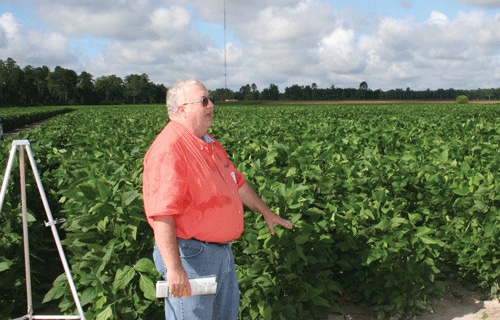
Soybean rust threat fading
The hot, dry weather that has dogged the upper Southeast since mid-April appears to have at least one silver lining — the threat of soybean rust is just about gone and an additional diagnostic tool is coming online to give Southeastern growers even more tools to avoid rust damage in the future.
September 3, 2010

Veteran Asian soybean rust chaser John Mueller comes just short of saying the risk for Asian soybean rust is over for 2010, but does point out that the intense summer heat and dry weather and severe winter weather has pushed the disease organism farther south than in recent years.
Speaking at a recent field day Mueller said, “For the past five years we’ve been concerned that Asian soybean rust would come into South Carolina and be a big problem for us. Based on that threat we have developed a monitoring system (sentinel plots) that can detect infection on one leaf out of a hundred in one of these plots and we’re now able to give growers a 2-3 week notice of when they need to spray.
“This year we’ve had one of the consistently coldest winters we’ve ever had — even down into Mexico where some of our rust over-winters. Because of that the live hosts needed for rust to over-winter were killed off in the winter.
“The end-result is rust is really late developing this year. Typically, we pick up our first rust in our sentinel plots from Aug. 15 to Sept. 15. By Aug. 15, the closest rust to South Carolina is in the Florida Panhandle and barring the perfect storm — some combination of hurricanes or tropical storms, it’s not likely to get here in time to do any damage to our soybeans, Mueller says”
Some growers are getting excited about rust-like yellowing on soybean leaves. Mueller, who is also director of Clemson’s Edisto Agricultural Research and Extension Center in Blackville, S.C., explains the yellowing is downy mildew coming in as soybeans begin to flower. Downy mildew is typical and not likely to cause a lot of yield loss, he says.
Limit fungicide applications
Mueller urged South Carolina soybean growers to wait until small pods develop and try to limit this year’s crop to one application of fungicides. “If spraying for diseases other than rust, it’s still better to wait for those small pods to form. Unless we get a series of tropical storms, we don’t need to be spraying for these other diseases, if all we’re getting is afternoon thunderstorms,” Mueller says.
Multiple spraying of any pesticide on soybeans this year is going to be a management challenge because when soybeans in many areas of the Upper Southeast were in full bloom, they were hit with 95 degree temperatures and higher. When daytime temperatures reach 95 degrees, soybeans shed flowers.
As a result of the heat, most soybean growers in the Southeast are going to have to manage two crops of soybeans on one plant. This makes limiting fungicide applications to one all the more important, Mueller adds.
In addition to the good news/bad news about winter cold and summer heat and its affect on soybean rust, growers will have a new tool to use to better manage the threat of damage from Asian soybean rust.
This new tool, dubbed Soybean Rust Yield Loss Prediction Tool has been developed by several Southeast universities in cooperation with the USDA and their counterpart in Brazil — EMBRAPA.
Growers can access the new tool by going to the University of Kentucky’s Web site (Kentucky scientists took the lead in developing the new tool). The Web address is: http://dept.ca.uky.edu/sbrtool.
The new tool turns data about potential yield and the presence of soybean rust into a prediction of economic outcomes. Using the tool, growers can make data-based management decisions as to managing the risk of rust.
Though Asian soybean rust has been a constant threat to soybean growers for the past five years, it has never caused any widespread economic losses — nothing even close to damage caused in Brazil’s soybean crop virtually every cropping year.
The new tool will further reduce the risk to U.S. soybean growers. To use the tool, users enter information about cost of a fungicide application, predicted yield and expected crop sale price. When soybean rust appears in a field, the user enters the soybean growth stage at the time. The tool does the rest.
Useful data
Using the data that was entered, the tool generates information for yield, return per acre and net returns. The information is based on three possible outbreaks: Severe, moderate and light, and yields and returns are further categorized based on whether or not a fungicide is applied.
“The options are given in order to provide the producer with at least some information on possible outcome depending on how soybean rust plays out during the season in a given area,” says Don Hershman, plant pathologist with the University of Kentucky.
The yield and economic estimates the tool generates are based on actual research data from 47 U.S. and 39 Brazil fungicide trials.
Hershman says, “The tool was developed using data generated in Brazil and the southern U.S. Therefore, the tool has greatest applicability in the South — no one is certain how far north the tool will be useful to growers.”
Weather alone seems to be protecting Southeastern growers from Asian soybean rust in 2010. In future years, the highly sophisticated sentinel system and the new risk evaluation tool offer good hope the disease will never create the kind of economic damage it does in the Southern Hemisphere.
e-mail: [email protected]
About the Author(s)
You May Also Like





